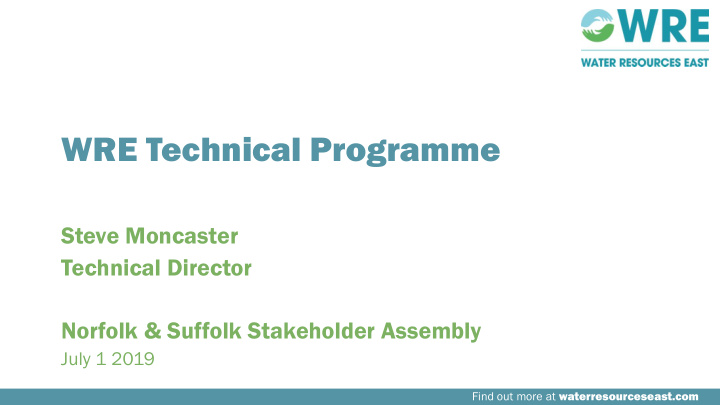



WRE Technical Programme Steve Moncaster Technical Director Norfolk & Suffolk Stakeholder Assembly July 1 2019 Find out more at waterresourceseast.com
Contents 1. Background • Water resources in Norfolk & Suffolk • National planning framework Programme elements • • Overall WRE approach 2. Environmental Land Management schemes 3. Priority catchment projects 4. Regional Planning 5. Value of the WRE Programme in Norfolk & Suffolk Key message: We are planning for a strong economy and a flourishing environment in Norfolk • & Suffolk • Each element of our technical programme supports delivery of the national planning framework • We are implementing measures to strengthen our non-PWS planning effort Find out more at waterresourceseast.com
Background The water resource planning problem in Norfolk & Suffolk Norfolk and Suffolk water resources: • Dominated by groundwater but with locally significant abstraction from surface water Limited resource availability • • Significant environmental pressure from abstraction and poor water quality • There will be less water in the future for people, businesses and the environment Find out more at waterresourceseast.com
National Planning Framework For water resources National Planning Framework • Draft WRE regional water Requirements for regional plans resource management plan needed by August 2021 • Final draft by August 2022 • Must include water needs of PWS and other sectors • Must consider enhanced environmental improvements Find out more at waterresourceseast.com
WRE programme elements Meeting the needs of the national planning framework Phase II WRE regional strategy Priority catchment projects …WRE will also join up Environmental with flood risk management Land Management plans scheme (ELMs) Find out more at waterresourceseast.com
Overall WRE approach Working in the water-energy-food-environment nexus We’re planning for: • Public water supply (PWS) • Irrigated agriculture & food processing • Manufacturing industries • Energy & power generation • Environment Martinez, P. (2018) Our vision is for a strong economy in the WRE region and a flourishing Laspidou, C. (2018) environment Find out more at waterresourceseast.com
Phase II WRE regional planning South Approach Humber • Phase II regional plan will be developed using b same multi-sector trade-off approach as Phase I Bank a The non-PWS elements are being strengthened • • We are planning to map conservation priorities across the region and use these to coordinate input from eNGOs c • We have set up a network of sub-regional planning groups to assess non-PWS issues in detail and develop a bigger & f better portfolio of multi-sector options d g Key Planning Group Issues & Priorities Planning Group PWS Energy Agrifood Manufacturing Environment e a h b c i d e f g h OxCam Arc i Find out more at waterresourceseast.com
Priority Catchment projects General approach Find out more at waterresourceseast.com
Interreg project summary “Water for Tomorrow” Priority Catchment project Purpose • Reduce the cost of drought by improving access to water during periods of water scarcity Approach • Shared vision planning & real-time management of the available resources Deliverables • A catchment based multi-sector planning process Other benefits include: • A web-based catchment management system tool 1. More/better options A “Water For Tomorrow” toolkit & training programme • for managing flood risk Principal economic and environmental benefits 2. Opportunities to • Potential for deferred expenditure on drought related shape the future of abstraction reform capital schemes and test different • Reduced vulnerability to drought restrictions “Catchment System Operator” approaches More water for the environment • Find out more at waterresourceseast.com
Interreg budget summary Taking opportunities to reduce the cost of our programme Gross costs & contributions from partners Notes: • Total gross cost: £2,374k 1. We are working with Lincolnshire • WRE: £1,190k County Council and other partners on a similar project in the South Forty • Environment Agency: £419k Foot Drain Catchment – the “Smart Water Management” project 2. We are promoting a water trading • French BRGM: £391k project on the lower Nene and lower Ouse systems involving abstractors, French Syndicats: £374k • drainage authorities and others Net Costs • Total net cost £712k • Net cost for WRE: £357k (approximately 15% total project cost) Find out more at waterresourceseast.com
ELM project distribution and type Integrated land and water management Lincolnshire fen & limestone Lincolnshire beck farm cluster landscape scale Norfolk fen & limestone wet and dry beck heath single farm Lincolnshire fenland Norfolk single farm landscape scale chalk streams Cambridgeshire Suffolk trout stream chalk streams farm cluster farm cluster
Proposed ELM objectives & approach Farming water Test different ways to deliver water related public goods • Clean & plentiful water • Thriving plants & wildlife • Reduction in harm from natural hazards such as flooding & drought • Enhanced beauty, heritage and engagement with the natural environment Test the market for water related private goods Pollution control • • Flood control • Drought risk mitigation Sustainable abstraction • General approach • Farmer led partnerships with environmental NGOs, water companies and others
WRE value added In Norfolk & Suffolk At regional scale: more joined up Water Resource Management Plans (WRMPs) for Anglian Water & Essex and Suffolk Water To maximise the net environmental gain and • other multi-sector benefits from the AW strategic water grid and any future reservoir(s) in the Anglian region At sub-regional scale: more integrated approach to water resource management and planning • Improved access to water during droughts • Increased resilience for the natural systems on which all abstractors depend • “…more, bigger, better and joined places for nature…” (Lawton Review, 2010) Find out more at waterresourceseast.com
Thank you. Any Questions? . Find out more at waterresourceseast.com
Recommend
More recommend